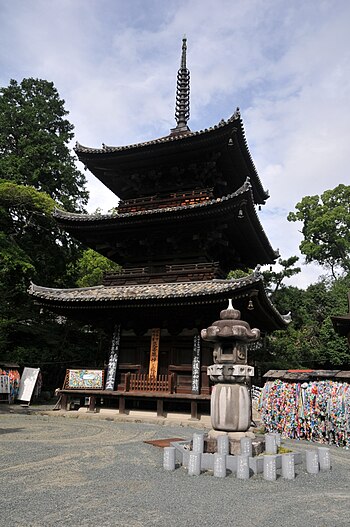Ishite-ji (石手寺) is a Shingon temple in Matsuyama, Ehime Prefecture, Japan. It is Temple 51 on the Shikoku 88 temple pilgrimage. Its name means Stone Hand Temple (石手寺). Seven of its structures have been designated National Treasures or Important Cultural Properties.



History
editThe temple of Annoyō-ji was founded by Gyōki, and converted from a Hossō to a Shingon temple by Kūkai. Rebuilt by the ruler of Iyo Province in the eighth century, many of the temple buildings were destroyed by the Chōsokabe in the sixteenth century. The aetiology sees the temple's name changed to Ishite-ji or stone-hand temple after the tightly-clenched hand of the newborn son of the lord of Iyo Province was opened by a priest from the Annoyō-ji to reveal a stone inscribed "Emon Saburō is reborn".[1]
Buildings
edit- Niōmon (二王門) (1318) (National Treasure)[2][3]
- Three-storey pagoda (三重塔) (late Kamakura period) (Important Cultural Property)[4][5]
- Hondō (本堂) (late Kamakura period) (ICP)[6][7]
- Kariteimotendō (訶梨帝母天堂) (late Kamakura period) (ICP)[8][9]
- Shōrō (鐘楼) (1333) (ICP)[10][11]
- Gomadō (護摩堂) (Nanboku-chō period) (ICP)[12][13]
Treasures
edit- Gorintō (五輪塔) (late Kamakura Period) (Important Cultural Property)[14][15]
- Bronze bell (銅鐘) (1251) (ICP)[16][17]
- Inscription of 1567 telling the legend of Emon Saburō[18]
- Casket housing the eponymous stone.[18]
See also
editNotes
edit- ^ Miyata, Taisen (2006). The 88 Temples of Shikoku Island, Japan (vid. pp. 102f.). Koyasan Buddhist Temple, Los Angeles.
- ^ "Database of Registered National Cultural Properties". Agency for Cultural Affairs. Retrieved 21 March 2011.
- ^ "Ishiteji Niōmon". Matsuyama City. Archived from the original on 23 July 2011. Retrieved 20 April 2011.
- ^ "Database of Registered National Cultural Properties". Agency for Cultural Affairs. Retrieved 21 March 2011.
- ^ "Ishiteji Sanjūnotō". Matsuyama City. Archived from the original on 23 July 2011. Retrieved 20 April 2011.
- ^ "Database of Registered National Cultural Properties". Agency for Cultural Affairs. Retrieved 21 March 2011.
- ^ "Ishiteji Hondō". Matsuyama City. Archived from the original on 23 July 2011. Retrieved 20 April 2011.
- ^ "Database of Registered National Cultural Properties". Agency for Cultural Affairs. Retrieved 21 March 2011.
- ^ "Ishiteji Kariteimotendō". Matsuyama City. Archived from the original on 23 July 2011. Retrieved 20 April 2011.
- ^ "Database of Registered National Cultural Properties". Agency for Cultural Affairs. Retrieved 21 March 2011.
- ^ "Ishiteji Shōrō". Matsuyama City. Archived from the original on 23 July 2011. Retrieved 20 April 2011.
- ^ "Database of Registered National Cultural Properties". Agency for Cultural Affairs. Retrieved 21 March 2011.
- ^ "Ishiteji Gomadō". Matsuyama City. Archived from the original on 23 July 2011. Retrieved 20 April 2011.
- ^ "Database of Registered National Cultural Properties". Agency for Cultural Affairs. Retrieved 21 March 2011.
- ^ "Ishiteji Gorintō". Matsuyama City. Archived from the original on 23 July 2011. Retrieved 20 April 2011.
- ^ "Ishiteji bell". Matsuyama City. Archived from the original on 23 July 2011. Retrieved 20 April 2011.
- ^ "Database of Registered National Cultural Properties". Agency for Cultural Affairs. Retrieved 20 April 2011.
- ^ a b Reader, Ian (2005). Making Pilgrimages: Meaning and Practice in Shikoku. University of Hawaii Press. pp. 60f. ISBN 978-0-8248-2907-0.
References
edit- Banzai, Mayumi. (1973). A Pilgrimage to the 88 Temples in Shikoku Island. Tokyo: Kodansha. OCLC 969829
- Miyata, Taisen. (2006). The 88 Temples of Shikoku Island, Japan. Los Angeles: Koyasan Buddhist Temple. OCLC 740530179
- Reader, Ian. (2005). Making Pilgrimages: Meaning and Practice in Shikoku. Honolulu: University of Hawaii Press. ISBN 9780824828769; OCLC 56050925